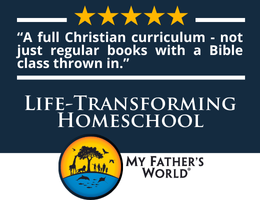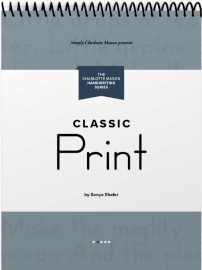Simply Charlotte Mason has handwriting courses in either the classic Zaner-Bloser style or the slant print/cursive D’Nealian style. A bundle of five books takes children from printing capital letters through cursive instruction and copywork practice in the style of your choice. Books can also be purchased individually. Children beginning the first book in either style should be able to recognize the letters of the alphabet and their sounds.
Charlotte Mason methodology is explained at the beginning of each book. In keeping with that methodology, lessons in the first two books last no more than five minutes a day, move at the child’s pace, and use multisensory methods (writing in a sand tray and on a slate before writing in the book). The first book has children write their first letters on unlined pages until they have sufficient small motor control to write on lines toward the end of the book. In the last three books, children practice with copywork, paying attention to details to ensure they have transcribed words and sentences correctly.
The titles for the books in each series begin with either the word Slanted or Classic and are completed with the following titles:
- Capitals (print)
- Print (adds lowercase print)
- Cursive
- Cursive Quotations, Volume 1
- Cursive Quotations, Volume 2
Books are available in print or as PDFs. Printed books have a spiral binding at the top that allows them to lie flat, making them easy to write in and keeping the binding out of the way for left-handed writers.
The first three books have 72 lessons each, to be completed at a rate of two per week. These lessons are scripted; parents can read instructions for forming letters and completing exercises as children follow along and respond. The instructions at the beginning of the first book explain how lessons should be adapted to provide the sensory experience and practice students need before writing in their books, and it’s critically important that parents follow those instructions rather than always sticking to the script. The last two books do not require instruction for each lesson and are not scripted.
Capitals and Print
Both series follow the same progression and use the same content. The style of handwriting is the only difference.
The books teach the letters according to common strokes. For example, the first lessons in the first two books begin with horizontal and vertical strokes that are used to form the letters T, I, H, E, F, and L in the Capitals book, and i, t, and l, in the Print book. In Capitals, children write only individual letters. Pages for children to write on are unlined until the last seven lessons, since beginning writers often have difficulty keeping letters a consistent size and writing on lines.
Print lessons have children write on lines in all lessons, and they begin writing short words in the third lesson. Beginning with the sixth lesson, a word with a capital letter is often included so students don’t forget the capital letter forms. Lesson 18 begins to introduce copywork sentences in occasional lessons. Six “exams” are included in the book, but think of them as opportunities to identify letters with which students need more practice. Exams present seven lowercase letters and ask students to write both lowercase and uppercase forms, or they present a line of five lowercase words to copy. The final, two-part exam has them copy the complete sentence that contains all the letters: “The quick brown fox jumps over the lazy dog." Lessons 56 through 72 are exclusively copywork.
Cursive
Lessons in the rest of the book still take no more than five to ten minutes, and children might continue to use a sand tray and slate. Models are provided throughout the course since children are learning letter formation.
The Cursive book sometimes teaches letters with common strokes together or in adjacent lessons. Children might continue to use a sand tray and slate as they learn cursive letter formation. At first, the lessons have children fill in only the missing letter(s) of words since they don’t yet know how to form all the letters. For instance, as they learn the letter i, they write only that letter in the blank space in the words skillful, in, his, will, and kings (e.g., sk llful). They are shown models of tricky joins between letters before they write them. They start to write a few complete words in the seventh lesson and continue to have lessons with complete words about every fourth or fifth lesson. In lessons introducing new letters, they fill in an increasing number of letters missing from words through Lesson 26. Cursive capitals are taught beginning with Lesson 57. Six “exams” have students copy words and phrases in the first four, but have children write verses from Proverbs without models in the final two. It’s important to note that children retain printing skills by copying a proverb in seven lessons.
Cursive Quotations, Volume 1and Volume 2
The Cursive Quotations books both have 36 lessons that are to be completed at a rate of one per week. Both use quotations from children’s literature, beginning with short sentences and gradually increasing to lengthy, complex sentences. Parents will read the new sentence for each lesson and discuss its language and meaning, and then students copy the sentence and compare their work with the model.
The primary difference between the two volumes is the lines. Volume 1 begins with larger 5/8-inch lines (with a dotted line through the middle) and gradually transitions to smaller lines without a midline. Volume 2 uses only lines the size of those on regular notebook paper.
Handwriting Supplies Kit
If you are starting with one of the first three books, you might want the Handwriting Supplies Kit. It has a 5”x 7” slate, a soapstone pencil, a 5” x 7” sand tray, a bag of sand, and a standard pencil with a silicon pencil grip.
Summary
The Simply Charlotte Mason handwriting books use a gentle, age-appropriate approach for teaching handwriting, while also teaching students to be attentive and diligent.









